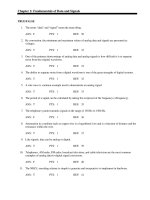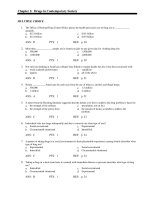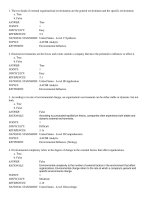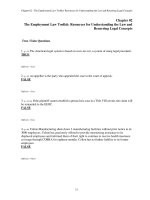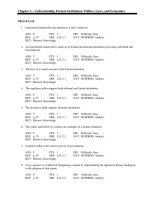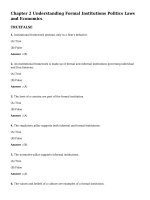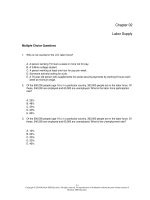Employment law for business 7th edition bennett alexander test bank
Bạn đang xem bản rút gọn của tài liệu. Xem và tải ngay bản đầy đủ của tài liệu tại đây (69.17 KB, 20 trang )
Chapter 02 - The Employment Law Toolkit: Resources for Understanding the Law and Recurring Legal Concepts
Chapter 02
The Employment Law Toolkit: Resources for Understanding the Law and
Recurring Legal Concepts
True / False Questions
1. (p. 43) The American legal system is based on stare decisis, a system of using legal precedent.
TRUE
Difficulty: 1 Easy
2. (p. 44) An appellee is the party who appealed the case to the court of appeals.
FALSE
Difficulty: 1 Easy
3. (p. 44, 46) If the plaintiff cannot establish a prima facie case in a Title VII lawsuit, the claim will
be remanded to the EEOC.
FALSE
Difficulty: 1 Easy
4. (p. 60) Colton Manufacturing shuts down 3 manufacturing facilities without prior notice to its
3000 employees. Colton has graciously offered to provide outsourcing assistance to its
displaced employees and informed them of their right to continue to receive health insurance
coverage through COBRA for eighteen months. Colton has no further liability to its former
employees.
FALSE
Difficulty: 3 Hard
2-1
Chapter 02 - The Employment Law Toolkit: Resources for Understanding the Law and Recurring Legal Concepts
5. (p. 57) Hannah Bing was hired by Friendly Catering Company. The employee handbook stated
that employees would only be terminated for good cause. Hannah was fired and replaced by her
supervisor's niece. Hannah cannot file a wrongful discharge lawsuit against Friendly Catering
Company because she is an employee-at-will.
FALSE
Difficulty: 2 Medium
6. (p. 58) Promissory Estoppel is an exception to the employment-at-will doctrine if the employee
can show that he/she relied on the employer's promise to his/her detriment.
TRUE
Difficulty: 1 Easy
7. (p. 60) Major Tire Company's plant in Charleston, South Carolina was destroyed when
Hurricane Hazel hit the coast. The company officially closed the facility after reviewing the
damage and terminated all 500 workers. The company did not give the employees 60 days'
notice, and it is liable under the WARN Act.
FALSE
Difficulty: 3 Hard
8. (p. 64) An employer can successfully defend a charge of disparate treatment discrimination
under Title VII of the Civil Rights Act by offering a legitimate, nondiscriminatory reason for
the action taken regarding the charging party.
TRUE
Difficulty: 2 Medium
9. (p. 74) Punitive damages are permitted in Title VII cases, but not in disparate impact cases or
against government employers.
TRUE
Difficulty: 2 Medium
2-2
Chapter 02 - The Employment Law Toolkit: Resources for Understanding the Law and Recurring Legal Concepts
10. (p. 62) If Sally's employer subjects her to more severe discipline for an act of misconduct than
a similarly situated fellow employee not in her protected group for the same act of misconduct,
Sally is being subjected to disparate treatment discrimination.
TRUE
Difficulty: 2 Medium
11. (p. 70) Questions asked during idle conversational chat during preemployment interviews or
included on job applications may unwittingly be the basis for Title VII claims of disparate
impact.
TRUE
Difficulty: 1 Easy
Multiple Choice Questions
12. (p. 45, 46) When a party wins a Motion for Summary Judgment
A. the case is remanded to the lower court
B. there are triable issues of fact
C. there are no triable issues of fact
D. Both A and B.
Difficulty: 2 Medium
2-3
Chapter 02 - The Employment Law Toolkit: Resources for Understanding the Law and Recurring Legal Concepts
13. (p. 57) Davis Hosiery Mills has each new employee sign a form acknowledging receipt of the
company's handbook. The handbook states that employees will be terminated for good cause
only. It also contains a disclaimer, in small print, which informs the employee that the
employment relationship is "at will." An employee of Davis Hosiery sues for wrongful
termination.
A. The employee cannot sue because termination for good cause is not generally recognized as
a limitation to employment-at-will, even when placed in an employee handbook.
B. Davis Hosiery will win the case because the employee signed a form acknowledging that the
employment relationship at Davis Hosiery is "at will."
C. Depending on the statutes or court decisions in the state where Davis Hosiery is located, the
employee can proceed with the lawsuit because the disclaimer was neither prominent nor
conspicuous.
D. The employee cannot sue if she lost her copy of the handbook.
Difficulty: 2 Medium
14. (p. 54-55) Mr. Johnson, a white male, testified for the plaintiffs in a racial discrimination
lawsuit brought by a black female employee against his employer, Security Bank. He had been
advised by his manager not to get involved. Shortly thereafter, Mr. Johnson was fired.
A. Mr. Johnson has no case for retaliatory discharge because he is not a member of the
protected class.
B. Mr. Johnson has no case for retaliatory discharge because merely testifying on behalf of
someone else is insufficient involvement in a discrimination lawsuit to get protection against
retaliatory discharge under Title VII of the Civil Rights Act.
C. Mr. Johnson has no case for retaliatory discharge because he is an employment-at-will
employee.
D. Mr. Johnson may have a case because Title VII of the Civil Rights Act protects an employee
who participates in any manner in an investigation, proceeding or hearing on a colleague's
complaint of discrimination.
Difficulty: 3 Hard
2-4
Chapter 02 - The Employment Law Toolkit: Resources for Understanding the Law and Recurring Legal Concepts
15. (p. 47) The employment-at-will doctrine means that
A. An actor must agree to follow the instructions by the play's director in order to be cast in a
play by William Shakespeare.
B. Highly paid skilled workers in the building trades can pass their jobs on to a relative when
they die.
C. An employer can terminate an employee for any reason as long as the reason is not a
violation of public policy or against the law.
D. Government employees lose their constitutional rights when on the job.
Difficulty: 1 Easy
16. (p. 51) Ms. Lee was employed as a secretary at Burton Trucking. She was fired from her job
when she refused to perjure herself at a trial where her employer was the defendant. She filed a
wrongful discharge lawsuit against her former employer. Ms. Lee will
A. prevail if the state where the lawsuit was filed recognizes a public policy exception to the
employment-at-will doctrine.
B. prevail only if she proves she was telling the truth.
C. will lose because the employment-at-will doctrine completely insulates the employer from
liability.
D. will lose because her testimony provided the basis for a defamation lawsuit by her former
employer.
Difficulty: 2 Medium
17. (p. 52) Octavia is an employee of DFC, Inc., a defense contractor. She discloses to the
Department of Justice information relating to fraud in carrying out a defense contract on which
she is working. DFC subsequently fires her. Octavia then files a lawsuit against DFC for
violating the Federal Whistleblower Statute.
A. Octavia's case will be dismissed.
B. Octavia can win compensatory damages only.
C. Octavia can win compensatory and punitive damages.
D. Octavia can win reinstatement only.
Difficulty: 3 Hard
2-5
Chapter 02 - The Employment Law Toolkit: Resources for Understanding the Law and Recurring Legal Concepts
18. (p. 60) Mr. Jones was employed by Barker Sock Company as a sewing machine repairman in
Plant #5. He, along with the other 700 employees, was informed that the plant had been
permanently closed by a written notice on the door when he arrived at work.
A. Mr. Jones' only recourse is to file for unemployment benefits.
B. Mr. Jones has no recourse because he was an employee-at-will.
C. Mr. Jones may be eligible to receive his salary and benefits for the next 60 days.
D. None of the choices are correct.
Difficulty: 3 Hard
19. (p. 52) Cortney was employed at Brunson County Elementary School as a cook. Her
supervisor routinely took extra food and other supplies home. Cortney was fired after she
reported the theft to the police and local newspaper.
A. Cortney does not have a cause of action for wrongful discharge.
B. Cortney may have a cause of action pursuant to the "whistle-blowers" exception to the
employment-at-will doctrine.
C. Cortney is an employee-at-will and can be terminated at any time for any reason.
D. None of the choices are correct.
Difficulty: 2 Medium
20. (p. 52) Mathias is an employee for Burton Commercial Realty. He receives a modest salary,
however, his salary is supplemented by substantial commissions. He has been working on a
commercial real estate deal for 5 months, two weeks before the deal closes, he is fired and
Burton does not pay him his commission:
A. Mathias has a cause of action for breach of implied covenant of good faith.
B. Mathias has a cause of action for retaliatory discharge.
C. Mathias has a claim under the Civil Service Reform Act.
D. None of the above.
Difficulty: 2 Medium
2-6
Chapter 02 - The Employment Law Toolkit: Resources for Understanding the Law and Recurring Legal Concepts
21. (p. 54) A retaliatory discharge claim under Title VII requires
A. that the employee has either participated in the statutory complaint process or opposed some
form of discrimination.
B. an adverse action taken with regard to the employee's employment status.
C. a causal connection between the adverse employment action and the employee's
participation in the statutory process.
D. All of the choices are correct.
Difficulty: 2 Medium
22. (p. 61) Natalie resigned from her position as floor supervisor at Martin's Department Store.
The store manager told the other employees that she had been fired for coming to work drunk.
He also communicated that information to someone calling to verify Ms. Weston's previous
employment with Martin's Department Store.
A. Ms. Weston has no recourse against her former employer because the store manager is a
known liar.
B. Ms. Weston is an at-will employee and therefore has no cause of action against Martin's
Department Store.
C. Ms. Weston may have a cause of action against Martin's Department Store for defamation.
D. None of the choices are correct.
Difficulty: 3 Hard
23. (p. 57) Harrison was hired by SportsTV to broadcast the local high school sports games.
During the interview, Harrison was told that the company had plans to expand its coverage of
team sports to college and professional sports. He was told that he would be getting in on the
ground floor and would have an opportunity to move up with the company as it grew. Harrison
was given a timeline for expansion that covered the next ten years. Armed with this knowledge,
Harrison accepted the job and moved to Greensboro, North Carolina from Atlanta, Georgia.
After 18 months, the management at SportsTV fired Harrison and replaced him with a local
athlete with more name recognition.
A. Harrison has cause of action for breach of contract.
B. Harrison has a cause of action for breach of implied contract.
C. Harrison has no recourse because he is an employee-at-will.
D. Harrison has no recourse because he did not have a written contract.
Difficulty: 3 Hard
2-7
Chapter 02 - The Employment Law Toolkit: Resources for Understanding the Law and Recurring Legal Concepts
24. (p. 59) Sarah was employed at Carlson Printing Company as the Sales Manager. After a year
on the job, Paul became her new supervisor. Paul was constantly yelling at Sarah and telling her
she was stupid. Sarah was so nervous when Paul was around that she started to stutter. After
working with Paul for 6 months, Sarah sought treatment from a psychiatrist for depression.
Shortly thereafter, Sarah quit her job and filed a wrongful discharge lawsuit against Carlson
Printing Company.
A. Sarah is an employee-at-will and has no right to her job.
B. Sarah has valid claim for constructive discharge.
C. Carlson Printing Company is not liable for wrongful discharge because Sarah quit her job,
she was not fired.
D. Carlson Printing Company is not liable for wrongful discharge because Paul was not acting
within the scope of his authority.
Difficulty: 2 Medium
25. (p. 54) Harrison works in a cubicle at a window next to Karen Ravenwood's cubicle at
Tabernacle Insurers. One day, Harrison overhears Karen's supervisor make a comment that
she'd be more successful if she spent as much time on shaping her list of prospective customers
as she does on shaping her body. Karen files a complaint of sex/gender discrimination with the
EEOC and Harrison is called to testify during the investigation. The EEOC decides not to
pursue the matter. A month and a half after the investigation is closed, Tabernacle management
moves Harrison from his cubicle to a cubicle on a vacant floor. All other aspects of his job
remain the same. Harrison files a complaint of retaliation.
A. Harrison cannot pursue a case of retaliation because the relocation of his work area between
cubicles did not materially affect the terms, conditions, or privileges of his employment at
Tabernacle.
B. Harrison cannot prove a case of retaliation because the investigation uncovered no
wrongdoing.
C. Harrison cannot prove a case of retaliation because he is not in the same protected group as
Karen.
D. Harrison can prove a case of retaliation.
Difficulty: 2 Medium
2-8
Chapter 02 - The Employment Law Toolkit: Resources for Understanding the Law and Recurring Legal Concepts
26. (p. 61) Cara works in the packaging and shipping department of the John Quincy Adams Mint
& Collectibles Company. For the past few weeks, some special commemorative coin sets have
been disappearing. The company used metal detectors and searched employee lockers and
belongings in the plant but no contraband was found. Now, in an effort to catch the wrong-doers,
the company stops the car of each packing and shipping department employee, including Cara
as they leave the plant parking lot. The search of Cara's car did not turn up any coins but she was
terminated because the search revealed that her car's glove compartment contained some sex
toys that she had put in a John Quincy Adams Mint & Collectibles Company gift box.
A. Cara has no recourse because she should have been more careful about storing her personal
belongings in her car.
B. Cara should be reinstated to her job because she was not terminated for a just cause.
C. Cara may have an action against the Mint for wrongful invasion of privacy.
D. Cara may have a cause of action against the Mint for violating her constitutional right
against an unwarranted search and seizure.
Difficulty: 2 Medium
27. (p. 55-56) Alana Brown was employed by the Quality Protection Security Company as a
security officer at a local military base. While off duty, she participated in a rally protesting U.S.
participation in the Iraq war. Chief of Security Felix Bratfurter saw Officer Brown on the
evening television news. The next day, Chief Bratfurter fired Officer Brown.
A. Officer Brown has no recourse because the protections of employee constitutional rights
only apply when the employer is a government agency and she was employed by a private
company.
B. Officer Brown has a cause of action for wrongful discharge because she cannot be fired for
exercising her constitutional right to free speech.
C. Officer Brown has a cause of action for breach of contract.
D. None of the choices are correct.
Difficulty: 1 Easy
2-9
Chapter 02 - The Employment Law Toolkit: Resources for Understanding the Law and Recurring Legal Concepts
28. (p. 59) Carla Thomas, a nonsmoker, often encouraged her co-workers to quit smoking. Her
new manager, Paul, a smoker, was annoyed by what he considered her constant nagging. He
moved her desk from a separate room with a window to a cubicle surrounded by smokers, who
smoked all day. Paul refused Carla's request to create a no smoking area in the office and he
refused her request to be moved back to the separate room. After 4 weeks of breathing second
hand smoke, Carla quit.
A. Carla has no recourse against her employer because she is an employee-at-will.
B. Carla can file a lawsuit based on discrimination because non-smokers are a protected class.
C. Carla may have a cause of action for constructive discharge.
D. None of the choices are correct.
Difficulty: 2 Medium
29. (p. 63) In a prima facie case of disparate impact discrimination, the claimant must establish
that the claimant is a member of a protected class protected under Title VII and that:
I. the claimant applied for and was qualified for a job for which the employer was seeking
applicants.
II. the claimant was rejected and, after the rejection, the position remained open.
III. the employer continued to seek applicants with the rejected applicant's qualifications.
A. I and II.
B. II and III.
C. I, II, and III.
D. None of the above.
Difficulty: 1 Easy
30. (p. 65) The bona fide occupational qualification defense (BFOQ) can be used by the employer
to defend Title VII discrimination claims when the basis is
A. Sex/gender, religion, national origin, race or color
B. Sex/gender, national origin, race or color
C. Religion, national origin, race or color
D. Sex/gender, religion, national origin
Difficulty: 1 Easy
2-10
Chapter 02 - The Employment Law Toolkit: Resources for Understanding the Law and Recurring Legal Concepts
31. (p. 74) Every successful claimant in a Title VII case is eligible to receive
A. back pay, front pay, and liquidated damages.
B. back pay, front pay, attorney fees, and punitive damages.
C. back pay, front pay, attorney fees, punitive damages, and compensatory damages.
D. back pay, front pay, and compensatory damages.
Difficulty: 3 Hard
32. (p. 67, 71) Major Industries has a published workplace policy that reads: "Promotions to the
level of supervisor and higher are limited to individuals with at least a bachelor's degree from an
accredited college or university."
A. Although this is a facially neutral policy, it could be found to be discriminatory if it can be
shown by statistics that it has a disparate impact on a protected group, unless Major Industries
can prove a business necessity for the policy.
B. There is nothing facially neutral about this policy because there are lots of people who are in
supervisory or higher positions who never earned a degree from a college or university.
C. Although this is a facially neutral policy, it could be found to be discriminatory if it can be
shown by statistics that it has a disparate impact on a protected group, unless Major Industries
can prove a bottom line defense.
D. Although this is a facially neutral policy, it could be found to be discriminatory if it can be
shown by statistics that it has a disparate impact on a protected group, unless Major Industries
can prove a subjective qualifications defense.
Difficulty: 2 Medium
2-11
Chapter 02 - The Employment Law Toolkit: Resources for Understanding the Law and Recurring Legal Concepts
33. (p. 74) Karen Rogers was employed at the Pentagon as manager of the Purchasing Department.
Prior to the arrival of her new supervisor in June of 2004, she received the highest employee
rating on her yearly evaluation. Her new supervisor, John Lincoln, had been overheard saying
that he did not believe that women were smart enough to manage a department. Six months later,
Karen was fired for poor work performance. If she wins her claim for gender discrimination,
Karen may be entitled to
I back pay
II reinstatement to her former position
III punitive damages
A. I only
B. I and II only
C. I, II, and III
D. All of the choices are correct.
Difficulty: 3 Hard
34. (p. 65) Dean Capers, an African American, was employed as a bus driver with Mountain City
Transportation Department. The city council voted to reduce the number of bus routes, and
Dean's job was eliminated. Dean filed a claim with EEOC alleging racial discrimination
because he was the only African American bus driver and he had more seniority than 4 of the
drivers retained. Mountain City successfully responded
A. by showing that Dean was selected for lay off because he had a bad attitude and there had
been several complaints filed against him.
B. by using the bona fide occupational qualification defense.
C. by using the business necessity defense.
D. none of the choices are correct.
Difficulty: 3 Hard
35. (p. 63) Marc Brown is a chemical engineer with a graduate degree from MIT. Mr. Brown is
African American. He applied for a chemical engineering position with Kincaid Paper
Company. Although he was qualified for the job, he was not offered the position. Mr. Brown
happened to see the job advertised in the newspaper 2 weeks after he had been rejected.
A. Mr. Brown does not have a cause of action for discrimination.
B. Mr. Brown can offer evidence to satisfy the elements of a prima facie case.
C. Mr. Brown cannot offer evidence to satisfy the elements of a prima facie case.
D. Mr. Brown is not eligible to file a claim under Title VII.
Difficulty: 3 Hard
2-12
Chapter 02 - The Employment Law Toolkit: Resources for Understanding the Law and Recurring Legal Concepts
36. (p. 67-68) BJI Enterprises requires all employees to pass a standardized test before being
considered for promotions. Marisa Chavez, a Hispanic female, was employed in the
Maintenance department as a housekeeper. She wanted to be considered for a supervisory
position in that department. However, she could not make a passing score on the test. There
were no minority supervisors in the Maintenance Department. The Civil Rights Act requires
A. BJI to show that the test is related to the job.
B. Ms. Chavez to show that the test is not related to the job.
C. Ms. Chavez to prove that she is qualified for the job.
D. None of the choices are correct.
Difficulty: 3 Hard
37. (p. 69) The four-fifths rule states that
A. only 20% of the employees affected by the screening device can be minorities or there is a
presumption of disparate impact discrimination.
B. minorities must do at least 80% as well as the majority on the screening device or there is a
presumption of disparate impact discrimination.
C. after the claim has been filed, the employer must offer evidence to prove that four-fifths of
all employees are successful when the screening device is used.
D. None of the choices are correct.
Difficulty: 3 Hard
38. (p. 71) The Business Necessity Defense requires the employer to show
A. that the challenged policy is job related and is a legitimate requirement for the job.
B. that there is a legitimate, nondiscriminatory reason for the alleged discriminatory conduct.
C. that the information provided by the employee is false.
D. None of the choices are correct.
Difficulty: 2 Medium
2-13
Chapter 02 - The Employment Law Toolkit: Resources for Understanding the Law and Recurring Legal Concepts
39. (p. 70-71) James Helton, an African-American, was hired as a dock worker with Coastal
Distributing Company. As a full time employee, he was eligible for health insurance benefits if
he met certain criteria. His pre-employment physical indicated that he suffered from
hypertension or high blood pressure. The company's health insurance plan excluded employees
that had that condition. Hypertension is a condition that is common among African-Americans
and affects that race at a much higher percentage than any other race.
A. Coastal Distributing Company's policy is not discriminatory because it applies to all
employees, regardless of race.
B. Coastal Distributing Company's policy is discriminatory because more African-Americans
will be denied health insurance than employees who are not African-American.
C. Coastal Distributing Company's policy is not subject to Title VII because it involves
employee benefits, not hiring, promotion or termination.
D. Coastal Distributing Company's policy is discriminatory because it treats some employees
differently (African Americans) than other similarly situated employees.
Difficulty: 3 Hard
40. (p. 64, 65, 71) The following defenses are available to employers in discrimination claims:
A. bona fide occupational qualification (BFOQ) defense
B. legitimate, nondiscriminatory reason defense
C. business necessity defense
D. All of the choices are correct.
Difficulty: 2 Medium
41. (p. 71, 92) Which of the following is not a business necessity providing a defense to a disparate
impact claim?
A. Hiring only cashiers that are bondable.
B. Hiring only brunettes to work as servers in a restaurant because they are preferred by
customers and bring larger profits for the company.
C. Hiring only pizza deliverers who possess driver's licenses.
D. Hiring only English speaking workers to be telephone operators.
Difficulty: 2 Medium
2-14
Chapter 02 - The Employment Law Toolkit: Resources for Understanding the Law and Recurring Legal Concepts
42. (p. 71) Emmanuel and Petersen is an extremely busy law firm specializing in litigation. In
order to keep up with their workload, they refuse to hire anyone as a secretary who is unable to
type at least 65 words per minute. If a group of male applicants challenges this policy as being
discriminatory against generally slower typing males, the company could defend the
typing-speed requirement as a:
A. bottom line defense.
B. disparate treatment defense.
C. business necessity.
D. bona fide disparate impact defense.
Difficulty: 3 Hard
43. (p. 73) McFerrin was refused employment by Billiot, Inc., because he failed to achieve a high
enough score on a valid, reliable skills test. Believing that he has been the victim of national
origin discrimination, since no one of Scottish descent has ever achieved a satisfactory score,
McFerrin sues under Title VII after exhausting his administrative remedies. He asks the court to
require Billiot to adjust the scores of all Scottish-descent test-takers, upward, by ten points.
Assuming McFerrin proves national origin discrimination, can the court grant the relief he
seeks?
A. No, because the Civil Rights Act of 1964 makes it an unfair employment practice for an
employer to adjust the scores of an employment-related test on the basis of a protected trait.
B. Yes, because the Civil Rights Act of 1964 requires an employer to adjust the scores of an
employment-related test on the basis of a protected trait, if the effect of the test is to exclude
certain groups from a certain minimum level of employment.
C. No, because the Civil Rights Act of 1991 makes it an unfair employment practice for an
employer to adjust the scores of an employment-related test on the basis of a protected trait.
D. Yes, because the Civil Rights Act of 1991 requires an employer to adjust the scores of an
employment-related test on the basis of a protected trait, if the effect of the test is to exclude
certain groups from a certain minimum level of employment.
Difficulty: 3 Hard
2-15
Chapter 02 - The Employment Law Toolkit: Resources for Understanding the Law and Recurring Legal Concepts
44. (p. 71) NorthernSky Airlines is a regional carrier that flies a variety of aircraft with maximum
interior cabin heights ranging from 6'2¼" to 5'9." NorthernSky advertisements for flight
attendants state that an applicant "must be between 5'0" and 5'8" without shoes due to the
internal size of our aircraft." James, a 6' 0" man complains that the height restrictions have a
disparate impact on men. The airline defends the case by asserting that height is a business
necessity for the job.
A. James will prevail on his complaint because he can fit inside some of the aircrafts.
B. NorthernSky will prevail because it can demonstrate that the flexibility to schedule flight
attendants on all its aircraft is a reasonable necessity for normal operation.
C. James will prevail on his complaint because height restrictions have nothing to do with the
primary responsibility of a flight attendant, which is the safety of the passengers.
D. NorthernSky will prevail because it can demonstrate that a shorter flight attendant is innately
better suited to perform the "non-mechanical" functions of the job, such as soothing nervous
customers.
Difficulty: 2 Medium
45. (p. 70-71) The Bright Creek Luggage Company has hired you as a consultant to improve the
company's hiring processes so it will be less vulnerable to claims of discrimination when hiring.
You should make the following recommendations.
A. Bright Creek should scrutinize prepared interview questions and employment applications
to determine whether there is a disparate impact in the way that information is elicited.
B. Bright Creek should require all outside recruiters and employment agencies to certify that
they are familiar with the requirements of anti-discrimination laws.
C. Bright Creek should provide training on basic legal concepts for equal employment
opportunity to all interviewers and persons who make hiring decisions.
D. All of the answers are correct.
Difficulty: 1 Easy
2-16
Chapter 02 - The Employment Law Toolkit: Resources for Understanding the Law and Recurring Legal Concepts
Essay Questions
46. (p. 51) Explain the public policy exception to the doctrine of employment at-will, including
stating what the ex-employee must demonstrate to prevail and give at least three examples of
the public policy exception that have been recognized by some of the states.
The public policy exception protects an employee who has engaged in conduct that society
wants to encourage. The ex-employee must show that the employer's actions were motivated by
bad faith, malice, or retaliation. A violation of public policy can occur when the employee is
terminated for an act such as refusing to violate a criminal statute on behalf of the employer or
at the employer's request, exercising a statutory right (e.g., voting), fulfilling a statutory duty
(e.g., serving on a jury) or disclosing violations of statutes by an employer (e.g., violation of
laws and regulations designed to protect public safety).
Difficulty: 2 Medium
47. (p. 60) What are the requirements imposed on employers by the Worker Adjustment and
Retraining Notification (WARN) Act? List and discuss the exceptions to this Act.
The WARN Act requires employers to give its employees 60 days advance notice of a plant
closing or mass layoff. Notice is required if the plant closing will result in loss of employment
for 50 or more workers in a 30-day period. Notice is required if the mass layoff at one facility
during a 30-day period results in loss of employment for 500 or more workers or 50-499
workers if that number represents at least 1/3 of the total active workforce. An employer's
failure to comply with the WARN Act gives the affected employees the right to recover pay and
benefits for the time notice was not given, up to the statutory 60-day maximum.
The WARN Act also provides for exceptions to the 60-day notice requirement. First, the
"faltering company" exception allows an employer to forego notification of an imminent plant
closing or mass layoff if the employer is actively seeking capital and has a good faith belief that
notification to the employees would prevent the employer from receiving the necessary capital.
Secondly, the Act provides an exception to the notice requirement when the plant closing or
mass layoff is due to a sudden, unexpected business circumstance that was not foreseeable and
out of the employer's control. The final exception is for situations resulting from natural
disasters.
Difficulty: 1 Easy
2-17
Chapter 02 - The Employment Law Toolkit: Resources for Understanding the Law and Recurring Legal Concepts
48. (p. 62, 65) Linda was employed with Southern Telephone Company as a telephone operator for
ten (10) years. Bored with this job, she applied for an open position as a telephone repairman
which paid $10.00 per hour more than she was currently earning. This position required the
employee to be able to climb to the top of a telephone pole wearing a tool belt weighing
approximately 15 to 20 lbs to make repairs. Southern Telephone Company refused to admit
Linda into the training program for the position claiming that she was incapable of performing
the duties of the position because she was female. Discuss this scenario from both Linda's and
Southern Telephone Company's point of view, including the basis for the relevant claims and
defenses.
Linda can file a claim with EEOC alleging disparate treatment discrimination in violation of
Title VII of the Civil Rights Act of 1964. Specifically, Linda would allege that she was denied
training for the new position because she was female, thus, she was treated differently because
of her gender in violation of Title VII. Southern Telephone Company can use the Bona Fide
Occupational Qualification Defense to defend against Linda's disparate treatment claim of
discrimination. The BFOQ defense allows an employer to engage in discriminatory practices if
it can be shown that the discrimination is necessary to the employer's business. In this instance,
the company can argue that it excludes women from training for the position as telephone
repairman because women would be unable to climb the telephone pole carrying the weight of
the tool belt. Furthermore, the employer should argue that while there may occasionally be a
woman that would be able to perform the duties of the job, it would be impracticable to allow
women to enter the training program, only to later be excluded due to the inability to climb the
pole wearing the tool belt.
Difficulty: 3 Hard
2-18
Chapter 02 - The Employment Law Toolkit: Resources for Understanding the Law and Recurring Legal Concepts
49. (p. 62, 67) Describe the two theoretical bases for lawsuits alleging discrimination under Title
VII of the Civil Rights Act of 1964.
Disparate Treatment discrimination requires that the plaintiff/employee allege that he/she was
treated differently than other similarly situated employees based on the plaintiff/employee's
race, color, gender, national origin or religion. This is intentional discrimination, but the
plaintiff/employee does not have to prove that the employer said that one of the prohibited
factors was the reason for the discriminatory conduct. It is enough for the plaintiff/employee to
produce evidence that shows that discrimination as the only plausible explanation for what
happened.
Disparate Impact discrimination occurs when an employer uses some type of screening device
or has an employment policy that is neutral on its face, but the device or policy can be shown,
by the use of statistics, to impact a protected group negatively. If such a policy impacts
protected groups more harshly than majority groups, illegal discrimination may be found if the
employer cannot show that the requirement is a legitimate business necessity.
Difficulty: 2 Medium
50. (p. 65, 71) Distinguish the business necessity defense from the bona fide occupational
qualification defense, including describing each defense and stating when each can be used.
A bona fide occupational qualification (BFOQ) is some skill or trait that is legitimately required
in order for an individual to adequately and properly perform a particular job. An employer may
defend against a claim of disparate treatment discrimination brought by an individual not
possessing the trait or skill by asserting that the trait or skill is a BFOQ. The BFOQ can be used
in cases involving allegations based on gender, religion or national origin but not for race or
color. The business necessity defense is available only in cases of unintentional or disparate
impact discrimination. It requires the employer to demonstrate that the performance of a
particular job by the use of particular methods or skills is reasonably necessary to the essence of
the employer's business.
Difficulty: 2 Medium
2-19
Chapter 02 - The Employment Law Toolkit: Resources for Understanding the Law and Recurring Legal Concepts
51. (p. 91) Describe the basic legal theory that is used to determine whether the plaintiff or the
defendant will prevail in a lawsuit in which it is alleged that the defendant has committed illegal,
disparate treatment employment discrimination, in violation of Title VII of the Civil Rights Act
of 1964, as amended, when there is no direct evidence of discrimination.
According to the pattern set forth in McDonnell Douglas v. Green, the plaintiff must prove all
elements of the prima facie case of discrimination alleged in the complaint. The burden then
shifts to the defendant to articulate some legitimate nondiscriminatory reason to explain the
alleged discriminatory act. If the defendant articulates such a reason, the plaintiff must then
prove that this nondiscriminatory reason is simply a pretext for another, illegally discriminatory
explanation of the defendant's alleged discriminatory act. If the plaintiff can successfully show
this, the plaintiff will prevail.
Difficulty: 2 Medium
2-20
